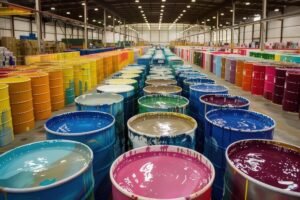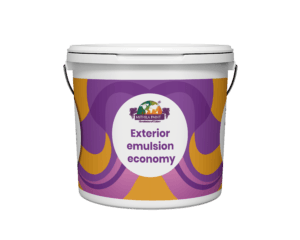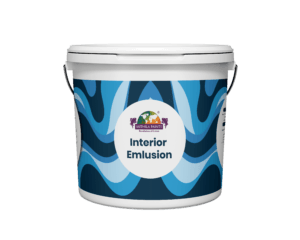Introduction to Quality Control in Paint Manufacturing in India
Quality control (QC) is a critical component in the paint manufacturing industry, serving as a systematic process aimed at maintaining and enhancing the consistency, performance, and safety of paint products. As consumers increasingly seek reliable and high-quality products for their homes, manufacturers must prioritize QC to meet these expectations. In this context, mithila home paints, a brand synonymous with quality, exemplifies the necessity of stringent QC practices in ensuring customer satisfaction.
One of the foremost aspects of quality control in paint manufacturing is the standardization of production processes. By establishing strict guidelines and parameters for the ingredients and formulations used, manufacturers can create a more uniform product. This standardization not only bolsters the reliability of the final product but also ensures that each batch of mithila home paints meets the established quality benchmarks. Furthermore, QC processes involve continuous monitoring during production to identify any deviations from these standards and implement corrective measures promptly.
Another vital function of quality control is to assess the performance characteristics of paint products, which include factors like adhesion, durability, and weather resistance. Rigorous testing protocols are instituted to evaluate these characteristics under various conditions, ensuring that the paint performs as intended over time. This scrutiny is particularly important in the paints industry, where subpar products may lead to increased customer dissatisfaction and potential safety hazards.
Moreover, the significance of health and safety cannot be overlooked in the context of quality control. Paint manufacturers are required to adhere to various regulatory standards that dictate the use of safe and environmentally friendly materials. By implementing robust QC measures, companies can ensure that their mithila home paints conform to safety regulations, fostering trust and confidence among consumers.

Key Components of Quality Control
Quality control in paint manufacturing is a multifaceted process that ensures the final products meet established standards. One of the primary components of this system involves rigorous raw material inspection. Prior to production, each material used in creating mithila home paints must undergo an extensive evaluation to confirm its purity, consistency, and adherence to specified guidelines. This inspection phase is crucial, as the quality of raw materials significantly influences the performance and durability of the finished product.
Another vital aspect of quality control is implementing in-process quality checks throughout the manufacturing process. Strategically positioned checkpoints allow for real-time assessments, helping to identify and rectify potential variances before they escalate into larger issues. These evaluations encompass the mixing, formulation, and application stages to ensure that each batch of mithila home paints maintains uniform viscosity and color consistency. By monitoring these variables constantly, manufacturers can promptly respond to any discrepancies, thus refining their production methods in a timely manner.
After production, final product testing is critical to validating the quality of mithila home paints. This stage involves assessing the paint against various performance criteria such as adhesion, drying time, and weather resistance. Laboratory tests are conducted to simulate real-life conditions, enabling companies to ascertain how well their products will withstand environmental factors. This testing phase not only helps to uphold a brand’s reputation by ensuring customer satisfaction but also solidifies compliance with industry regulations.
Each of these components—raw material inspection, in-process checks, and final product testing—contributes to a comprehensive quality control system. By interlinking these practices, paint manufacturers can ensure that their mithila home paints consistently achieve high-quality standards, ultimately benefiting end users.

Quality Control Procedures in a Paint Factory
Quality control (QC) in a paint manufacturing facility is an essential component that ensures the final product meets the expected standards. The procedures implemented in a paint factory are meticulously designed, incorporating systematic methodologies that encompass various stages of production. The primary aim is to uphold the integrity and reliability of products like mithila home paints and similar offerings.
The first step in the QC process involves sampling. This involves selecting representative batches from the production line at scheduled intervals. The sampling phase is critical, as it provides a snapshot of the overall quality of the paints produced. Once the samples are gathered, they proceed to the testing phase, where they undergo rigorous evaluations against specified standards. Physical attributes, such as viscosity, color consistency, and drying time, are assessed alongside chemical properties, including pH balance and pigment stability.
To ensure accurate testing, standardized operating procedures (SOPs) are employed. These SOPs outline the precise methods for conducting tests and calibrating equipment, thereby reducing variability and promoting reproducibility in results. Adhering to these protocols is paramount; it guarantees that each batch of mithila home paints maintains the quality that consumers expect. Moreover, the use of advanced testing methodologies, such as spectrophotometry and rheology testing, aids in delivering more accurate readings.
Documenting the findings of these tests is the next critical phase of the QC process. Every test result is recorded meticulously, forming a comprehensive database that can be reviewed for quality assessment and improvement purposes. This documentation is crucial not only for internal reference but also for compliance with industry regulations. By maintaining thorough records, a paint factory can ensure accountability and traceability, further strengthening their commitment to quality. Thus, the application of these meticulous quality control procedures plays a vital role in producing high-quality mithila home paints and ensuring customer satisfaction.

Role of Technology in Quality Control
In the modern landscape of paint manufacturing, the role of technology in quality control has become increasingly significant. Advancements such as automated testing devices and real-time monitoring systems are integral to ensuring that products meet stringent quality standards. These innovations allow manufacturers to conduct comprehensive assessments of raw materials and finished products with greater accuracy and efficiency.
Automated testing devices have revolutionized the inspection process within the industry. By enabling consistent and objective testing, these devices reduce human error, ensuring that every batch of mithila home paints adheres to predefined specifications. They can perform a variety of assessments, from viscosity and density to gloss and color matching, all in a fraction of the time it would take traditional methods. This swift assessment capability not only enhances quality assurance but also streamlines production cycles.
Moreover, real-time monitoring systems empower manufacturers to keep an eye on the production process continuously. These systems collect data continuously, providing immediate feedback on various parameters such as temperature, humidity, and mixing speeds. By analyzing this data, manufacturers can identify deviations from established norms early in the production process. Such proactive measures help mitigate the risk of producing subpar paints and ensure that every tin of mithila home paints is of the utmost quality.
Data management software further complements these technologies by compiling vast amounts of testing data into manageable insights. Through data analytics, manufacturers can track trends in quality control performance over time, which allows for informed adjustments to processes, materials, and formulations. This analytical approach not only supports the continuous improvement of quality standards but also fosters innovation in product development.
In summary, technology has a profound impact on quality control in paint manufacturing. Its integration has led to enhanced operational efficiency, improved accuracy in testing, and a stringent adherence to quality standards, thereby ensuring that products such as mithila home paints meet customer expectations reliably.
Challenges in Quality Control of Paints
Quality control in paint manufacturing is a multifaceted process that presents several challenges impacting product consistency and performance. One prominent issue is the variability in raw materials. The paint industry often relies on various organic and inorganic compounds, which may exhibit inconsistent properties due to fluctuations in sourcing. For instance, differences in pigment quality or variations in binder viscosity can lead to significant discrepancies in color shade and texture. Ensuring that raw materials maintain high standards is crucial for brands such as Mithila home paints, which emphasize reliability in their product offerings.
Another complex challenge arises from the formulation of paints. The intricate nature of paint formulations necessitates precise balancing of ingredients to achieve desired characteristics such as durability, drying time, and adhesion. Small alterations in formulation can result in products that are either underperforming or exceed specified criteria. Therefore, consistent testing and adjustments during the formulation process are essential for maintaining quality. Advanced analytical methods, such as spectroscopy or chromatography, can be employed to monitor formulations closely.
Environmental factors also play a key role in quality control. Conditions such as temperature and humidity can significantly influence the application and performance of paint products. For example, high humidity levels can affect the drying process, causing issues like blistering or poor adhesion. It is imperative for manufacturers to implement strict environmental controls within production facilities and to provide guidelines for end-users on optimal application conditions. Such measures can help in reducing the variability in final outputs and ensuring that products, including those from Mithila home paints, meet both aesthetic and functional expectations.

Regulatory Standards and Compliance
In the realm of paint manufacturing, adherence to regulatory standards is paramount in ensuring product quality and safety. Various regulatory bodies, including the Occupational Safety and Health Administration (OSHA), the Environmental Protection Agency (EPA), and the American Society for Testing and Materials (ASTM), set forth guidelines that influence manufacturing practices. Compliance with these regulations is not merely a bureaucratic obligation; it is a critical component of the quality control process that safeguards both consumers and the environment.
OSHA regulations primarily focus on workplace safety, ensuring that the manufacturing environment minimizes risks associated with exposure to hazardous materials. For paint manufacturers, adherence to these safety protocols is essential as workers may be exposed to fumes and chemical substances during the production process. Ensuring a compliant workplace helps mitigate health risks and improves overall efficiency, paving the way for the development of high-quality products such as mithila home paints.
The EPA plays a significant role in regulating the environmental impacts of paint production. Through guidelines that limit volatile organic compounds (VOCs) in industrial coatings, the agency aims to enhance air quality and protect public health. Manufacturers incorporating eco-friendly practices in their processes, including the use of low-VOC formulations in products like mithila home paints, benefit from reduced regulatory burdens while meeting consumer demand for safer alternatives.
Furthermore, ASTM provides critical standards related to the performance and durability of paints, including aspects such as adhesion, corrosion resistance, and color retention. Compliance with these standards not only assures manufacturers of their product’s quality but also enhances competitiveness in the market. Thus, meeting regulatory requirements significantly contributes to the integrity of the paint manufacturing sector, ensuring that customers receive reliable products while helping businesses maintain access to markets globally.
Employee Training and Development in QC
In the competitive landscape of paint manufacturing, including brands like mithila home paints, employee training and development play a pivotal role in maintaining and enhancing quality control standards. Quality control (QC) is integral to ensuring that products meet stringent specifications before they reach consumers. One of the most effective ways to uphold these standards is through comprehensive training programs for employees involved in the manufacturing process.
Training initiatives help equip employees with the necessary skills to identify defects in raw materials and finished products. This empowerment fosters a proactive approach to quality assurance, where employees are not merely passive participants but active contributors to the overall process. By incorporating real-life scenarios and hands-on training in a controlled environment, employees gain firsthand experience in spotting discrepancies that may affect the quality of paints, including those under the mithila home paints brand.
Moreover, continuous development programs ensure that employees stay updated with the latest advancements in paint production techniques and quality practices. This ongoing education helps them understand new technologies and methodologies that can be leveraged to improve product quality. A well-informed workforce can implement quality assurance measures more effectively and maintain the desired specifications across various production stages.
Additionally, fostering a culture of quality within the manufacturing facility promotes teamwork and accountability among staff members. Employees who recognize the significance of their contributions towards maintaining quality are more likely to take ownership of their roles, leading to reduced product flaws and minimized waste. Consequently, companies that prioritize employee training in QC not only maintain their market reputation but also enhance customer satisfaction through the consistent delivery of high-quality products like mithila home paints.

Case Studies of Successful QC Implementation
Quality control (QC) has become an indispensable element in the manufacturing of paint products, including innovative brands like Mithila home paints. This section examines notable case studies from the paint industry that illustrate the successful application of QC practices, highlighting the strategies employed and challenges surmounted by various manufacturers.
One exemplary case is that of a regional paint factory that recognized the need for systematic quality oversight due to increasing consumer complaints about product consistency. The factory adopted a proactive QC approach by integrating automated testing equipment into their production line. This allowed for real-time monitoring of color consistency and viscosity levels, essential aspects for achieving the ideal finish quality of mithila home paints and similar products. Not only did this result in reduced defect rates, but it also improved overall customer satisfaction, leading to increased brand loyalty.
Another compelling example is a multinational paint manufacturer that faced significant challenges with supply chain inconsistencies. To combat this, the company established a comprehensive QC framework that included regular supplier audits as well as material testing protocols. By collaborating closely with suppliers and implementing a feedback loop, they managed to significantly improve the quality of raw materials used in their paint production. This strategic focus on QC not only ensured that their products met established standards but also enhanced the reputation of their brand in the competitive marketplace of home paints.
Moreover, a smaller boutique paint manufacturer implemented a consumer feedback mechanism as part of their quality control process. By actively encouraging customers to report any issues and suggestions, the company was able to swiftly rectify problems and fine-tune their formulations. This customer-centric approach greatly contributed to the continuous improvement of their mithila home paints, showcasing how QC can be effectively oriented towards consumer engagement.
These case studies reveal that successful quality control practices hinge on the integration of technology, collaboration with suppliers, and active customer engagement. Lessons learned from these manufacturers can serve as valuable insights for other companies in the paint industry striving for excellence in product quality.
Future Trends in Quality Control for Paint Manufacturing
The landscape of quality control in paint manufacturing is poised for significant transformation in the coming years, driven by advancements in technology and an increasing emphasis on sustainability. One of the most notable trends is the increased adoption of automation throughout the production process. Automated quality control systems can enhance efficiency and accuracy, minimizing human error and ensuring that products, such as mithila home paints, meet stringent quality standards consistently. These systems allow for real-time monitoring and rapid adjustments, thus streamlining the manufacturing process.
Artificial Intelligence (AI) is also set to play a pivotal role in the evolution of quality control practices. AI algorithms can analyze vast amounts of data collected during production, identifying patterns and anomalies that human inspectors may overlook. This capability not only promotes a higher standard of quality but also enables predictive maintenance, which translates to reduced downtime and enhanced operational efficiency. Integrating AI into the quality assessment framework of paint manufacturing can ensure that products like mithila home paints are not only superior in quality but also tailored to the specific needs of consumers.
Another future trend may center on sustainability and environmental impact. As consumers become increasingly eco-conscious, paint manufacturers must prioritize eco-friendly practices within their quality control processes. This includes the use of sustainable raw materials, minimizing waste, and implementing processes that reduce the environmental footprint of production. Quality control will extend beyond merely assessing the performance of the paint itself to also encompass the environmental implications of its application. Emphasizing sustainability will not only meet consumer expectations but also align with regulatory standards, thereby fostering an overall positive image for brands associated with quality paints, including mithila home paints.










